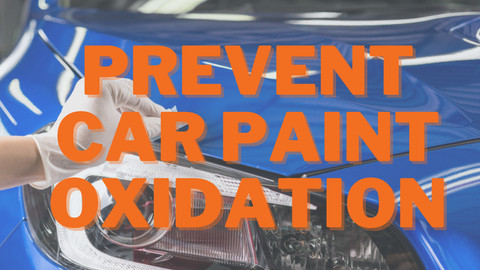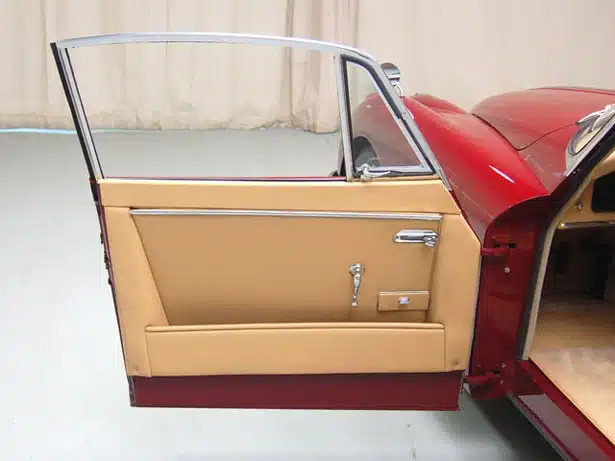How Much to Fix Paint Chip on Car: Cost & Solutions

Are you wondering how much to fix paint chips on your car and restore its flawless finish? CARDIAGTECH.NET offers expert insights into car paint chip repair costs and solutions to help you make informed decisions and find the perfect tools for the job. Discover the factors influencing repair expenses and explore effective methods to eliminate those unsightly blemishes, ensuring your vehicle looks its best.
Table of Contents
- Assessing the Damage: Types of Car Paint Damage
- Car Paint Repair Cost: A Comprehensive Guide
- Minor Damage Repair Costs
- Extensive Damage Repair Costs
- Factors Influencing the Cost of Car Paint Chip Repair
- Size and Depth of the Chip
- Location of the Chip
- Type of Paint
- Repair Method
- Labor Costs
- DIY vs. Professional Car Paint Chip Repair
- DIY Repair
- Professional Repair
- Step-by-Step Guide to DIY Car Paint Chip Repair
- Materials Needed
- Preparation
- Application
- Finishing
- When to Seek Professional Car Paint Chip Repair
- Extensive Damage
- Complex Paint Finishes
- Lack of Experience
- Choosing the Right Professional Car Paint Chip Repair Service
- Reputation and Reviews
- Experience and Expertise
- Warranty and Guarantees
- Cost and Estimates
- Maintaining Your Car’s Paint to Prevent Chips
- Regular Washing and Waxing
- Protective Coatings
- Careful Driving
- Parking Considerations
- Advanced Techniques in Car Paint Chip Repair
- Paintless Dent Repair (PDR)
- Color Matching Technology
- Ceramic Coatings
- The Environmental Impact of Car Paint Repair
- Eco-Friendly Products
- Waste Reduction
- Sustainable Practices
- Future Trends in Car Paint Repair Technology
- Self-Healing Paints
- Robotic Paint Repair
- AI-Powered Color Matching
- Frequently Asked Questions (FAQs) About Car Paint Chip Repair
1. Assessing the Damage: Types of Car Paint Damage
Before estimating the cost to fix paint chips on your car, it’s crucial to identify the type and extent of the damage. Different types of damage require different repair methods, which directly impact the overall cost. Here’s a breakdown of common types of car paint damage:
- Paint Chips: These are small pieces of paint that have broken off the car’s surface, often caused by road debris, rocks, or other impacts. Paint chips can range in size from tiny imperfections to larger, more noticeable blemishes.
- Scratches: Scratches are lines or marks on the car’s paint surface. They can be minor, affecting only the clear coat, or more severe, penetrating through the paint layers to the metal beneath.
- Scrapes: Scrapes occur when the car’s paint rubs against another object, such as a wall, pole, or another vehicle. Scrapes can remove paint and leave a rough, uneven surface.
- Dents: Dents are depressions in the car’s body panel, often caused by impacts. If a dent is accompanied by paint damage, it’s essential to address the dent first to ensure a smooth paint repair.
Understanding the specific type of damage will help you determine the appropriate repair method and estimate the associated costs more accurately. According to a study by the University of Michigan Transportation Research Institute, regular maintenance and prompt repair of minor damages can significantly extend the life of a vehicle’s paint and body.
 Minor car paint chips
Minor car paint chips
2. Car Paint Repair Cost: A Comprehensive Guide
How much does it cost to fix paint chips on your car? The cost to fix paint chips on a car can vary widely depending on the severity of the damage, the type of repair method used, and the location of the repair shop. Generally, you can expect to pay anywhere from $50 to $1,000 or more.
Minor Damage Repair Costs
For minor paint chips, scratches, and scrapes, the cost is typically lower. Here’s a breakdown:
- DIY Touch-Up Kit: $20 – $50
- Mobile Technician: $150 – $250 for multiple minor repairs
- Professional Touch-Up at a Body Shop: $50 – $150 per chip or scratch
A study by the National Automobile Dealers Association (NADA) found that minor cosmetic repairs can increase a vehicle’s resale value by up to 5%.
Extensive Damage Repair Costs
For more extensive damage, such as deep scratches, large scrapes, or damage covering multiple panels, the costs can escalate quickly:
- Mobile Spray Paint Services: $200 – $400 per panel
- Body Shop Repair: $250 – $600 per panel
- Full Car Repainting: $3,000 – $10,000+
According to data from Consumer Reports, the average cost to repaint a car is around $3,500, but this can vary significantly depending on the type of paint and the size of the vehicle.
3. Factors Influencing the Cost of Car Paint Chip Repair
Several factors can influence the cost to fix paint chips on your car. Understanding these factors will help you get a more accurate estimate and avoid surprises:
Size and Depth of the Chip
Larger and deeper chips require more extensive repair work, which increases the cost. Small, shallow chips can often be fixed with a simple touch-up, while larger chips may require filling, sanding, and repainting. According to a report by the Automotive Body Parts Association (ABPA), the size and depth of the damage are the primary drivers of repair costs.
Location of the Chip
The location of the chip on the car can also affect the cost. Chips in hard-to-reach areas or on curved surfaces may require more specialized techniques and labor, increasing the price. Additionally, chips near edges or seams may be more prone to spreading, necessitating more extensive repairs.
Type of Paint
The type of paint on your car can also impact the cost. Some paints, such as metallic or pearlescent finishes, are more difficult to match and blend, requiring more skilled technicians and specialized materials. According to PPG Industries, a leading automotive paint supplier, the complexity of the paint finish can add 10-20% to the cost of repair.
Repair Method
The chosen repair method will significantly impact the cost. DIY touch-up kits are the cheapest option, but they may not provide the best results for larger or more complex chips. Mobile technicians offer a convenient and affordable solution for minor damage, while body shops provide the most comprehensive repairs for extensive damage.
Labor Costs
Labor costs vary depending on the location and reputation of the repair shop. Shops in urban areas or with highly skilled technicians typically charge more per hour. It’s essential to get multiple estimates from different shops to compare labor costs and ensure you’re getting a fair price. According to the Bureau of Labor Statistics, the median hourly wage for automotive body and glass repairers was $23.59 in May 2023.
4. DIY vs. Professional Car Paint Chip Repair
When faced with paint chips on your car, you have the option of tackling the repair yourself (DIY) or hiring a professional. Each approach has its pros and cons, and the best choice depends on your skill level, budget, and the extent of the damage.
DIY Repair
Pros:
- Cost-Effective: DIY repair is the cheapest option, as you only pay for the materials.
- Convenient: You can perform the repair at your own pace and on your own schedule.
- Learning Experience: DIY repair can be a rewarding learning experience for car enthusiasts.
Cons:
- Skill Required: Achieving a professional-looking result requires some skill and experience.
- Time-Consuming: DIY repair can be time-consuming, especially for beginners.
- Potential for Mistakes: Mistakes can be costly and may require professional intervention.
Professional Repair
Pros:
- High-Quality Results: Professional technicians have the skills and tools to achieve a seamless repair.
- Convenience: You can drop off your car and let the professionals handle the repair.
- Warranty: Many professional repair shops offer a warranty on their work.
Cons:
- Higher Cost: Professional repair is more expensive than DIY repair.
- Scheduling: You may need to schedule an appointment and wait for the repair to be completed.
- Finding a Reputable Shop: It’s essential to find a reputable and experienced repair shop.
According to a survey by the American Automobile Association (AAA), 76% of car owners prefer to have their vehicles repaired by professional technicians due to concerns about quality and reliability.
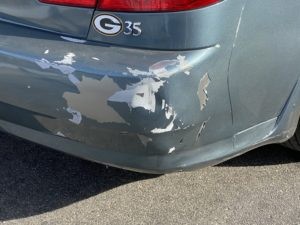 Extensive peeling of car paint
Extensive peeling of car paint
5. Step-by-Step Guide to DIY Car Paint Chip Repair
If you decide to tackle the repair yourself, here’s a step-by-step guide to fixing paint chips on your car:
Materials Needed
- Touch-Up Paint: Match the exact color code of your car’s paint. You can find this code on a sticker inside the driver’s side doorjamb or in the owner’s manual.
- Cleaning Supplies: Soap, water, and a clean microfiber cloth.
- Rubbing Alcohol: To remove any wax or grease from the chip.
- Fine-Tipped Applicator: A small brush, toothpick, or detailing swab.
- Clear Coat: To protect the repaired area.
- Rubbing Compound: To blend the repair with the surrounding paint.
- Wax: To protect the repaired area and enhance its shine.
- Sandpaper (Optional): For smoothing rough edges.
Preparation
- Wash the Area: Clean the area around the paint chip with soap and water, then dry it thoroughly.
- Remove Wax and Grease: Use rubbing alcohol to remove any wax or grease from the chip and the surrounding area.
- Sand Rough Edges (Optional): If the edges of the chip are rough, use fine-grit sandpaper to smooth them down.
Application
- Apply Touch-Up Paint: Use the fine-tipped applicator to apply a small amount of touch-up paint to the chip. Apply thin coats, allowing each coat to dry completely before applying the next.
- Build Up Layers: Continue applying thin coats until the paint is level with the surrounding surface.
- Allow to Dry: Let the paint dry completely, according to the manufacturer’s instructions.
Finishing
- Apply Clear Coat: Apply a thin layer of clear coat over the repaired area to protect the paint and enhance its shine.
- Allow to Dry: Let the clear coat dry completely.
- Apply Rubbing Compound: Use a clean microfiber cloth to apply rubbing compound to the repaired area, blending it with the surrounding paint.
- Wax the Area: Apply wax to the repaired area to protect it and enhance its shine.
Following these steps can help you achieve a professional-looking repair and save money on professional services. According to Popular Mechanics, patience and attention to detail are key to a successful DIY car paint chip repair.
6. When to Seek Professional Car Paint Chip Repair
While DIY repair can be a cost-effective solution for minor paint chips, there are situations where it’s best to seek professional help.
Extensive Damage
If the paint chip is large, deep, or covers a significant area, it’s best to consult a professional. Extensive damage may require specialized tools and techniques that are beyond the scope of DIY repair. Additionally, attempting to repair extensive damage yourself may result in a poor-quality repair that detracts from the appearance of your car.
Complex Paint Finishes
If your car has a complex paint finish, such as metallic, pearlescent, or multi-stage paint, it’s best to seek professional help. Matching and blending these types of paints requires specialized skills and equipment. A professional technician can ensure a seamless repair that is virtually undetectable.
Lack of Experience
If you lack experience in car paint repair, it’s best to consult a professional. Attempting to repair paint chips without the necessary skills and knowledge can result in a poor-quality repair that may be more costly to fix in the long run. A professional technician can provide a high-quality repair that will last for years to come.
According to a survey by the Automotive Service Association (ASA), 85% of car owners who attempted DIY repairs for extensive damage were ultimately dissatisfied with the results and sought professional help.
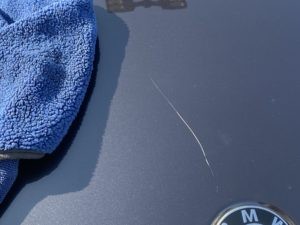 Minor scratch on car paint
Minor scratch on car paint
7. Choosing the Right Professional Car Paint Chip Repair Service
If you decide to seek professional help, it’s essential to choose the right repair service. Here are some factors to consider:
Reputation and Reviews
Check online reviews and ratings to get an idea of the repair service’s reputation. Look for reviews that mention the quality of the work, the professionalism of the staff, and the overall customer experience. Websites like Yelp, Google Reviews, and the Better Business Bureau can provide valuable insights.
Experience and Expertise
Choose a repair service with experienced and skilled technicians. Ask about the technicians’ training and certifications, and inquire about their experience with repairing paint chips on cars similar to yours. A repair service with a long history and a team of experienced technicians is more likely to provide a high-quality repair.
Warranty and Guarantees
Choose a repair service that offers a warranty or guarantee on its work. A warranty provides assurance that the repair service stands behind its work and will fix any issues that arise after the repair is completed. Be sure to read the fine print of the warranty to understand what is covered and for how long.
Cost and Estimates
Get estimates from multiple repair services to compare costs and services. Be sure to ask for a detailed breakdown of the estimate, including the cost of labor, materials, and any additional services. Keep in mind that the cheapest option is not always the best, and it’s essential to consider the quality of the work and the reputation of the repair service.
According to Consumer Reports, getting multiple estimates can save you up to 20% on car repairs.
8. Maintaining Your Car’s Paint to Prevent Chips
Preventing paint chips is always better than repairing them. Here are some tips for maintaining your car’s paint and preventing chips:
Regular Washing and Waxing
Wash your car regularly to remove dirt, debris, and contaminants that can damage the paint. Wax your car every few months to protect the paint and enhance its shine. Wax creates a barrier between the paint and the elements, helping to prevent chips and scratches.
Protective Coatings
Consider applying a protective coating to your car’s paint, such as paint protection film (PPF) or ceramic coating. PPF is a clear, adhesive film that is applied to the car’s surface to protect it from chips, scratches, and other damage. Ceramic coating is a liquid polymer that is applied to the car’s surface to create a durable, hydrophobic layer that repels water, dirt, and contaminants.
Careful Driving
Drive carefully and avoid roads with loose gravel or debris. Maintain a safe following distance from other vehicles to avoid being hit by rocks or other projectiles. Be especially cautious when driving behind trucks or construction vehicles, as they are more likely to kick up debris.
Parking Considerations
Park your car in a garage or carport whenever possible to protect it from the elements. If you must park outdoors, choose a spot away from trees, bushes, and other objects that could scratch the paint. Avoid parking in areas with high traffic or where other cars are likely to bump into yours.
According to the International Carwash Association (ICA), regular washing and waxing can extend the life of a car’s paint by up to 50%.
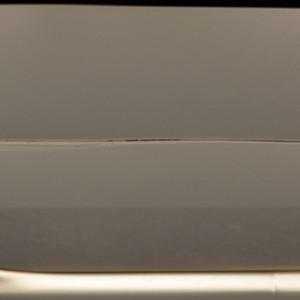 Extensive scratch on car paint
Extensive scratch on car paint
9. Advanced Techniques in Car Paint Chip Repair
The automotive industry is constantly evolving, and new techniques and technologies are emerging to improve the quality and efficiency of car paint chip repair.
Paintless Dent Repair (PDR)
Paintless dent repair (PDR) is a technique used to remove dents from a car’s body without damaging the paint. PDR involves using specialized tools to massage the metal back into its original shape. If a dent is accompanied by paint damage, PDR can be used to repair the dent before the paint is repaired.
Color Matching Technology
Advanced color matching technology is used to accurately match the color of the touch-up paint to the car’s original paint. This technology uses spectrophotometers to analyze the car’s paint and create a custom-blended paint that is a perfect match.
Ceramic Coatings
Ceramic coatings are becoming increasingly popular as a way to protect car paint from chips, scratches, and other damage. Ceramic coatings are applied to the car’s surface to create a durable, hydrophobic layer that repels water, dirt, and contaminants. Ceramic coatings can last for several years and provide long-lasting protection for your car’s paint.
According to a report by Grand View Research, the global automotive refinish coatings market is expected to reach $12.8 billion by 2027, driven by the increasing demand for advanced paint repair technologies.
10. The Environmental Impact of Car Paint Repair
Car paint repair can have a significant impact on the environment, and it’s essential to choose eco-friendly products and practices to minimize this impact.
Eco-Friendly Products
Choose eco-friendly car paint repair products, such as water-based paints and low-VOC (volatile organic compound) clear coats. Water-based paints and low-VOC clear coats emit fewer harmful chemicals into the atmosphere, reducing air pollution.
Waste Reduction
Reduce waste by using only the amount of paint and materials needed for the repair. Dispose of waste materials properly, following local regulations for hazardous waste disposal. Recycle used paint cans and other materials whenever possible.
Sustainable Practices
Choose a car paint repair service that follows sustainable practices, such as using energy-efficient equipment and recycling waste materials. Support companies that are committed to environmental responsibility and sustainability.
According to the Environmental Protection Agency (EPA), reducing VOC emissions from car paint repair can significantly improve air quality and protect public health.
11. Future Trends in Car Paint Repair Technology
The future of car paint repair is likely to be shaped by several emerging trends and technologies.
Self-Healing Paints
Self-healing paints are being developed that can automatically repair minor scratches and chips. These paints contain microscopic capsules that release a healing agent when the paint is damaged, filling in the scratch or chip and restoring the paint’s original appearance.
Robotic Paint Repair
Robotic paint repair systems are being developed that can automatically repair paint chips and scratches with minimal human intervention. These systems use advanced imaging and robotics technology to identify and repair damage with precision and efficiency.
AI-Powered Color Matching
AI-powered color matching systems are being developed that can accurately match the color of the touch-up paint to the car’s original paint using artificial intelligence and machine learning. These systems can analyze the car’s paint and create a custom-blended paint that is a perfect match, even for complex paint finishes.
According to a report by MarketsandMarkets, the global automotive coatings market is expected to reach $21.9 billion by 2025, driven by the increasing demand for innovative and sustainable coating technologies.
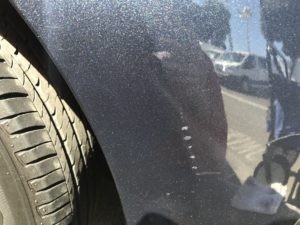 Minor scrape on car paint
Minor scrape on car paint
12. Frequently Asked Questions (FAQs) About Car Paint Chip Repair
Q: How much does it cost to fix a small paint chip on a car?
A: The cost to fix a small paint chip on a car typically ranges from $50 to $150 if you hire a professional. DIY kits can cost between $20 and $50, but the results may vary depending on your skill level.
Q: Can I fix a car paint chip myself?
A: Yes, you can fix a car paint chip yourself using a DIY touch-up kit. However, for larger or more complex chips, it’s best to seek professional help.
Q: What is the best way to prevent car paint chips?
A: The best way to prevent car paint chips is to wash and wax your car regularly, apply a protective coating, drive carefully, and park in a safe location.
Q: How long does it take to fix a car paint chip?
A: The time it takes to fix a car paint chip depends on the size and complexity of the chip. DIY repair can take a few hours, while professional repair may take a day or two.
Q: Will fixing a paint chip improve my car’s resale value?
A: Yes, fixing a paint chip can improve your car’s resale value by making it look more appealing to potential buyers.
Q: What is paintless dent repair (PDR)?
A: Paintless dent repair (PDR) is a technique used to remove dents from a car’s body without damaging the paint.
Q: Are water-based paints better for the environment?
A: Yes, water-based paints emit fewer harmful chemicals into the atmosphere, reducing air pollution.
Q: How often should I wax my car?
A: You should wax your car every few months to protect the paint and enhance its shine.
Q: What is the difference between paint protection film (PPF) and ceramic coating?
A: Paint protection film (PPF) is a clear, adhesive film that is applied to the car’s surface to protect it from chips and scratches, while ceramic coating is a liquid polymer that is applied to the car’s surface to create a durable, hydrophobic layer that repels water, dirt, and contaminants.
Q: How do I find the paint code for my car?
A: You can find the paint code for your car on a sticker inside the driver’s side doorjamb or in the owner’s manual.
Experiencing challenges with car paint chips and seeking reliable solutions? At CARDIAGTECH.NET, we understand the frustration of dealing with unsightly blemishes on your vehicle. That’s why we offer a comprehensive range of high-quality automotive tools and equipment to help you tackle paint chip repairs with confidence. Whether you’re a seasoned technician or a DIY enthusiast, our products are designed to deliver professional-grade results, ensuring your car looks its best.
Don’t let paint chips diminish the appearance of your vehicle any longer. Contact us today at +1 (641) 206-8880 or visit our website at CARDIAGTECH.NET to explore our extensive selection of automotive repair solutions. Our team of experts is ready to assist you in finding the perfect tools for your specific needs, empowering you to achieve flawless paint chip repairs and maintain the pristine condition of your car.
Reach out to CARDIAGTECH.NET now and discover how our top-notch products and unparalleled customer service can transform your car care experience. Let us help you restore your vehicle’s beauty and protect its value for years to come.





